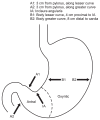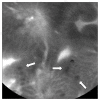Diagnosis and Management of Gastric Intestinal Metaplasia: Current Status and Future Directions
- PMID: 31394893
- PMCID: PMC6860040
- DOI: 10.5009/gnl19181
Diagnosis and Management of Gastric Intestinal Metaplasia: Current Status and Future Directions
Abstract
Gastric intestinal metaplasia (GIM) is a known premalignant condition of the human stomach along the pathway to gastric cancer (GC). Histologically, GIM represents the replacement of normal gastric mucosa by mucin-secreting intestinal mucosa. Helicobacter pylori infection is the most common etiologic agent of GIM development worldwide. The prevalence of GIM is heterogeneous among different regions of the world and correlates with the population endemicity of H. pylori carriage, among other environmental factors. GC remains the third leading cause of cancer-related mortality globally. GIM is usually diagnosed by upper endoscopy with biopsy, and histologic scoring systems have been developed to risk-stratify patients at highest risk for progression to GC. Several recent endoscopic imaging modalities may improve the optical detection of GIM and early GC. Appropriate surveillance of GIM may be cost effective and represents an opportunity for the early diagnosis and therapy of GC. Certain East Asian nations have established population-level programs for the screening and surveillance of GIM; guidelines regarding GIM surveillance have also recently been published in Europe. By contrast, few data exist regarding the appropriateness of surveillance of GIM in the United States. In this review, we discuss the pathogenesis, epidemiology, diagnosis, and management of GIM with an emphasis on the role of appropriate endoscopic surveillance.
Keywords: Epidemiology; Helicobacter pylori; Stomach.
Conflict of interest statement
No potential conflict of interest relevant to this article was reported.
Figures






Similar articles
-
AGA Clinical Practice Update on Screening and Surveillance in Individuals at Increased Risk for Gastric Cancer in the United States: Expert Review.Gastroenterology. 2025 Feb;168(2):405-416.e1. doi: 10.1053/j.gastro.2024.11.001. Epub 2024 Dec 23. Gastroenterology. 2025. PMID: 39718517 Review.
-
Prevalence, risk factors, and surveillance patterns for gastric intestinal metaplasia among patients undergoing upper endoscopy with biopsy.Gastrointest Endosc. 2020 Jan;91(1):70-77.e1. doi: 10.1016/j.gie.2019.07.038. Epub 2019 Aug 16. Gastrointest Endosc. 2020. PMID: 31425693
-
The road to a world-unified approach to the management of patients with gastric intestinal metaplasia: a review of current guidelines.Gut. 2024 Sep 9;73(10):1607-1617. doi: 10.1136/gutjnl-2024-333029. Gut. 2024. PMID: 39122364
-
Gastric Intestinal Metaplasia: Real Culprit or Innocent Bystander as a Precancerous Condition for Gastric Cancer?Gastroenterology. 2023 Dec;165(6):1352-1366.e1. doi: 10.1053/j.gastro.2023.08.028. Epub 2023 Aug 29. Gastroenterology. 2023. PMID: 37652306 Review.
-
Update on the Diagnosis and Management of Gastric Intestinal Metaplasia in the USA.Dig Dis Sci. 2019 May;64(5):1079-1088. doi: 10.1007/s10620-019-05526-5. Dig Dis Sci. 2019. PMID: 30771043 Review.
Cited by
-
The Transition from Gastric Intestinal Metaplasia to Gastric Cancer Involves POPDC1 and POPDC3 Downregulation.Int J Mol Sci. 2021 May 19;22(10):5359. doi: 10.3390/ijms22105359. Int J Mol Sci. 2021. PMID: 34069715 Free PMC article.
-
Evaluation of the Incidence of the Esophagogastric Pre-Cancerous Mucosal Lesions after Bariatric Surgery.Adv Biomed Res. 2023 May 30;12:140. doi: 10.4103/abr.abr_148_22. eCollection 2023. Adv Biomed Res. 2023. PMID: 37434923 Free PMC article.
-
Maize stover burning exposure accountable for remarkable environmental and health risk in broiler chickens.BMC Vet Res. 2025 Mar 25;21(1):199. doi: 10.1186/s12917-025-04476-7. BMC Vet Res. 2025. PMID: 40128693 Free PMC article.
-
The Relationship between Gastroduodenal Pathologies and Helicobacter pylori cagL (Cytotoxin-Associated Gene L) Polymorphism.Turk J Gastroenterol. 2023 Apr;34(4):346-355. doi: 10.5152/tjg.2023.22274. Turk J Gastroenterol. 2023. PMID: 36789984 Free PMC article.
-
Can Natural Products Suppress Resistant Helicobacter pylori to Fight Against Gastric Diseases in Humans?eFood. 2020 Feb;1(1):53-60. doi: 10.2991/efood.k.200211.001. Epub 2020 Feb 19. eFood. 2020. PMID: 34308385 Free PMC article.
References
Publication types
MeSH terms
LinkOut - more resources
Full Text Sources
Medical
Miscellaneous

